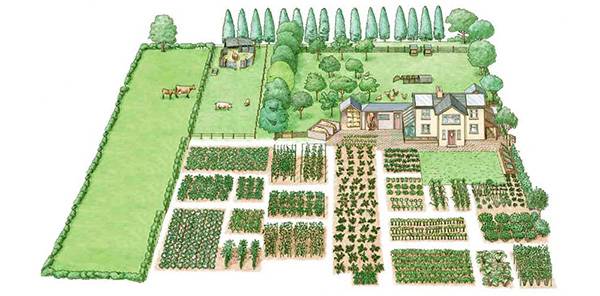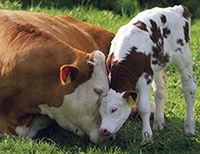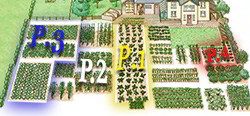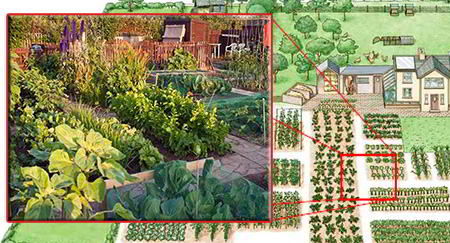| Online: | |
| Visits: | |
| Stories: |
How To Create Your Own 1-Acre, Self-Sustaining Homestead
One acre of good, well-drained land, can sustain a whole family all year long. You don’t necessarily need more than that. In case SHTF, one acre will be easier to protect than a large farm. Plus you can fence or maybe even hide “one acre farm”.
On one acre farm you can keep a cow, a goat, a few pigs and maybe a dozen hens. The goat would provide milk when the cow is dry.
Here’s a brief overview how you can turn one-acre of land into a self-sustaining homestead. (for sure this is not the only option)

Raising a Dairy Cow on Half Acre
There are a multitude of pros and cons to keeping a cow on your self-sustaining homestead, although mostly pros if you are willing to put in the extra work. Cows can provide milk, meat and their rich manure makes a great natural fertilizer.
 Fresh, all natural cow milk is healthy for you and your family, and it also benefits other livestock such as pigs and poultry. Cow manure will also promote better soil fertility so that your garden continually produces more delicious produce each year.
Fresh, all natural cow milk is healthy for you and your family, and it also benefits other livestock such as pigs and poultry. Cow manure will also promote better soil fertility so that your garden continually produces more delicious produce each year.
Still, a cow is an annual expense that can tally near a few hundred dollars each year, or more. If you can afford the original bill for keeping happy, healthy cows, you will make your money back with everything a cow has to offer.
It’s not difficult to milk a cow once you learn how, and it can be done in as little as 8 minutes. Cow’s milk can be used to make everything from cream, cheese and a delicious glass of milk.
It is not impossible to maintain a self-sustaining homestead without a cow, but it’s much easier to do so with a cow. If you plan to add a dairy cow to your yard, you will need to milk her regularly and if you plan to go out of town you will need someone experienced to take over while you are gone.
Pasture for Dairy Cow + Crop Rotation
 If you choose to keep a cow you can assume that half of your acre will be dedicated to pasture, which you may never plow, or you can plow every four-years if you plan to rotate crops.
If you choose to keep a cow you can assume that half of your acre will be dedicated to pasture, which you may never plow, or you can plow every four-years if you plan to rotate crops.
It is recommended to rotate crops in strips of a quarter of the half-acre, resulting in freshly sown pasture that varies in age. If you have freshly sown pasture that is 2-years-old, 3-years-old, and 4-years-old, you will have the most productive land usage.
How to Manage Grazing
If grass becomes overgrazed you need to remove cows from the area right away. Rotational grazing is a must in order to keep the grass healthy, as grass does best when it has plenty of time to fully grow before being grazed or cut down. It is so important to carefully manage grazing in order to prevent your entire pasture from turning to dust.
A half-acre of grass should keep a little Jersey cow plump all summer. It is unlikely you will have any leftover grass, but if you do it can be used to make hay. In order to prevent overgrazing, your cow will need a place to stay inside for the winter, but will still require some fresh air every day.
Intensive Gardening
The remaining half of your homestead — the arable half — would be farmed as a highly intensive garden. It would be divided, ideally, into four plots, around which all the annual crops that you want to grow follow each other in a strict crop rotation.
An ideal crop rotation might go something like this:
 — Grass (for four years)
— Grass (for four years)
— Plot 1: Potatoes
— Plot 2: Legumes (pea and bean family)
— Plot 3: Brassicas (cabbage family)
— Plot 4: Root vegetables (carrots, beets, and so on)
— Grass again (for four years)
Half Acre – Crop Rotation
Consider the advantages of this kind of crop rotation. A quarter of your arable land will be a newly plowed-up, 4-year-old field every year, with intensely fertile soil because of the stored-up fertility of all the grass, clover and herbs that have just been plowed-in to rot with four summers’ worth of cow manure. Because your cow will be in-wintered, on bought-in hay, and treading and dunging on bought-in straw, you will have an enormous quantity of marvelous muck and cow manure to put on your arable land.

All of the crop residues that you cannot consume will help feed the cow, pigs or poultry, and I would be surprised if, after following this crop rotation and grazing management plan for a few years, you didn’t find that your acre of land had increased enormously in soil fertility, and that it was producing more food for humans than many 10-acre farms run on ordinary commercial lines.
Some might complain that by having half your acre down to grass, you confine your gardening activities to a mere half-acre. But actually, half an acre is quite a lot, and if you garden it well, it will grow more food for you than if you were to “scratch” over a whole acre. Being under grass (and grazed and dunged) for half of its life will enormously increase the half-acre’s soil fertility. I think you will actually grow more vegetables on this plot than you would on a whole acre if you had no cow or grass break.
Self-Sufficient Homestead
Different animals require different living conditions, but all require some sort of indoor shelter for at least part of the year. Bedding for indoor stalls is something you must factor into your budget.
Animals will consume any food you do not; in fact you won’t need a compost pile with animals around.
Another self-sufficient system (a system totally independent from the environment) is a small aquaponic farm. Aquaponic systems can range from small backyard setups to vast commercial systems that fill up entire rooms. You can use fresh water or salt water. You can choose different types of fish and plants as well.
This information is adapted from The Self-Sufficient Life and How To Live It, written by the late John Seymour and first published by Dorling Kindersley in Britain in 1976. The book has become a treasured classic for back-to-the-landers and is now available in a beautifully illustrated 400-page edition.
Source: Askaprepper.com
Ingenious Foods People Made During Famines
What’s the #1 Killer In Any Crisis?
EMP survival and preparedness guide
Do You Make These Fatal Mistakes In A Crisis?




